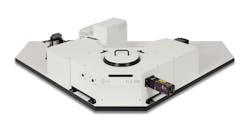Edinburgh Instruments fluorescence spectrometer features enhanced optics
The FLS980 fluorescence spectrometer is a fully automated modular device for steady state, lifetime, and phosphorescence measurements. Enhanced optics include high stray-light rejection monochromators and computer-controlled filter wheels for higher-order removal to allow accurate measurement of spectra without higher-order distortion. It has a signal-to-noise ratio of 12000:1.
Edinburgh Instruments
Livingston, Scotland
www.edinst.com
More Products
-----
PRESS RELEASE
FLS980 Fluorescence Spectrometer Launched By Edinburgh Instruments
Edinburgh Instruments, Photonics Division, Livingston, UK; Edinburgh Photonics announces the launch of the FLS980 fluorescence spectrometer for steady state, lifetime and phosphorescence measurements in photophysics, photochemistry, biophysics, biochemistry and semiconductor physics. Building on the success of the well-established FLS920 instrument, the FLS980 is a high performance, fully automated modular spectrometer for use in both fundamental research and routine laboratory applications. Improved sensitivity, sample handling, optics and control and analysis software are combined in an instrument that offers outstanding technical performance and flexibility for luminescence spectroscopy.
Enhanced optics include high stray light rejection monochromators, a 3-fold increase in monochromator options, and computer-controlled filter wheels for higher order removal to allow accurate measurement of spectra without higher order distortion. Instrument sensitivity is doubled compared to the FLS920, with a S/N of 12000:1 measured on the Raman spectrum of distilled water using single monochromators. This allows measurements of even lower sample concentrations and the use of smaller sample volumes.
Instrument modularity is reflected in a large sample chamber with 6-axis access to the sample and an improved ‘plug and play’ system of sample holders. A wide choice of sample holders allows easy configuration of the instrument for specific applications. With an extensive range of laser light sources, flashlamps and detectors available for the FLS980, spectral measurements can be made from 200nm to 5µm and with time resolution from a few picoseconds through to seconds.
A single, ultrafast data acquisition module accommodates any combination of light sources and detectors and provides easy set up and operation for Time Correlated Single Photon Counting (TCSPC), Multi-channel scaling (MCS) and spectral scanning alike.
A new, fully integrated, user friendly software package provides hardware control, performance monitoring, data acquisition, data analysis and data manipulation for all measurement modes. Full software set up and reconfiguration of sample holder options is provided. With advanced correction, measurement and analysis facilities, experiments can be readily designed from the PC. USB connectivity between the spectrometer and the PC brings fast data processing, module control and operation. Live profiles can be observed on screen as they are acquired before data manipulation and analysis.
